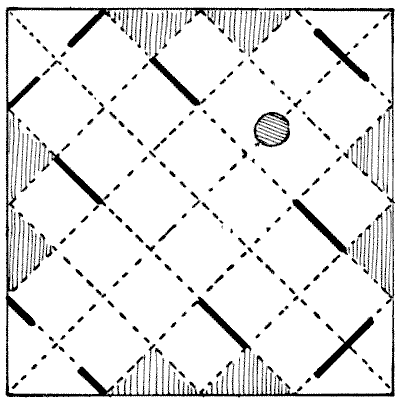(related to Section: Various Dissection Puzzles)
It may be interesting to introduce here, though it is not strictly a puzzle, an ingenious method for making a paper box.
Take a square of stout paper and by successive foldings make all the creases indicated by the dotted lines in the illustration. Then cut away the eight little triangular pieces that are shaded, and cut through the paper along the dark lines. The second illustration shows the box half folded up, and the reader will have no difficulty in effecting its completion. Before folding up, the reader might cut out the circular piece indicated in the diagram, for a purpose I will now explain.

This box will be found to serve excellently for the production of vortex rings. These rings, which were discussed by Von Helmholtz in 1858, are most interesting, and the box (with the hole cut out) will produce them to perfection. Fill the box with tobacco smoke by blowing it gently through the hole. Now, if you hold it horizontally, and softly tap the side that is opposite to the hole, an immense number of perfect rings can be produced from one mouthful of smoke. It is best that there should be no currents of air in the room. People often do not realize that these rings are formed in the air when no smoke is used. The smoke only makes them visible. Now, one of these rings, if properly directed on its course, will travel across the room and put out the flame of a candle, and this feat is much more striking if you can manage to do it without the smoke. Of course, with a little practice, the rings may be blown from the mouth, but the box produces them in much greater perfection and no skill whatever is required. Lord Kelvin propounded the theory that matter may consist of vortex rings in a fluid that fills all space, and by a development of the hypothesis, he was able to explain chemical combination.

This eBook is for the use of anyone anywhere in the United States and most other parts of the world at no cost and with almost no restrictions whatsoever. You may copy it, give it away or re-use it under the terms of the Project Gutenberg License included with this edition or online at http://www.gutenberg.org. If you are not located in the United States, you'll have to check the laws of the country where you are located before using this ebook.